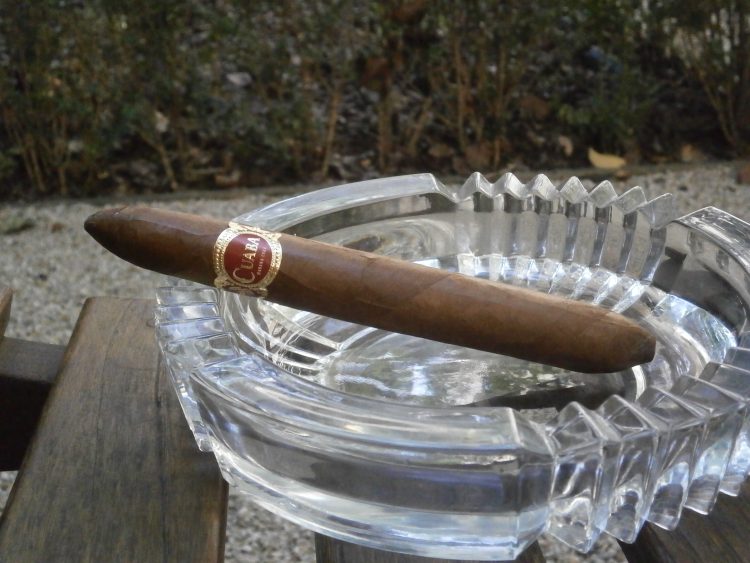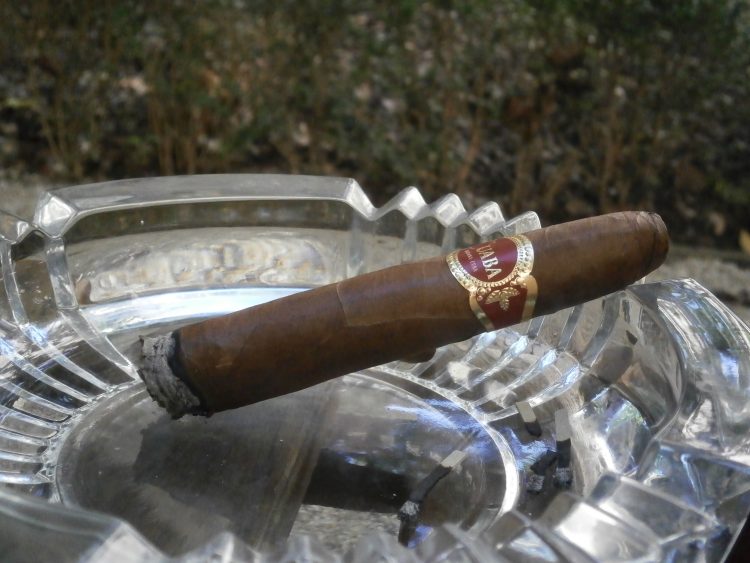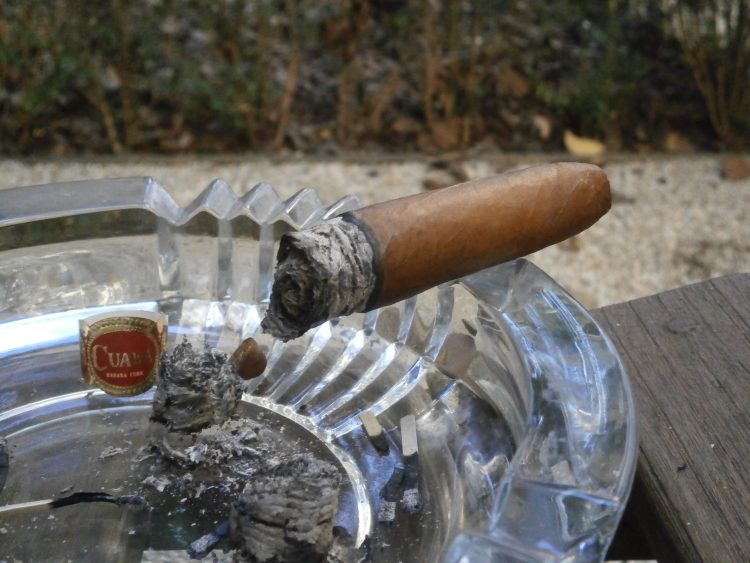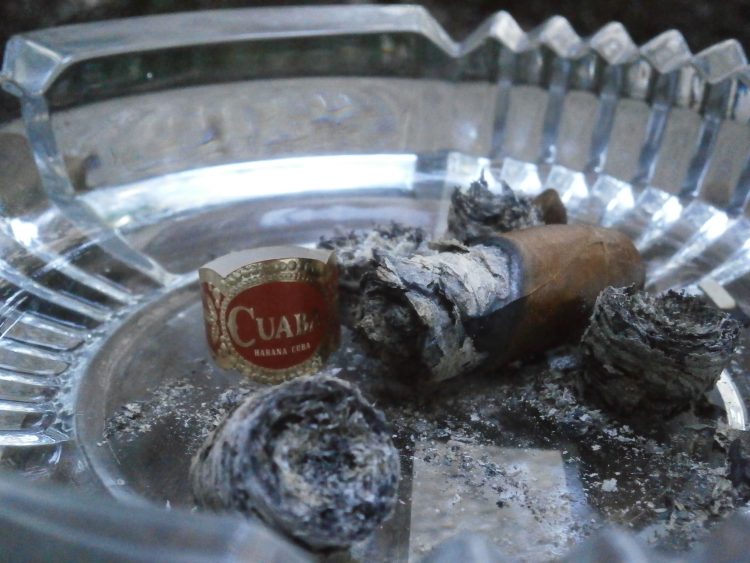very season of The Harem needs a whipping boy, a cigar that I can lambast as tasting of burning garbage or as having the acrid notes of chemical spill – it helps to preserve my reputation as an unbiased critic that doesn’t buy into the hype. Well, if there is to be a whipping boy this season, this might well be the one: the 2008 Edición Limitada from the loathsome Cuaba. Then again, perhaps not: of all the Cuaba cigars, this is the only one that I don’t recall ever hearing a bad word about.
Fun fact about Cuaba: Habanos occasionally cribs words from the Taino Indians (the pre-Columbian inhabitants of Cuba, functionally extinct thanks to some fairly vigorous genocide by Christopher and his colonial crew). One such word is Cohiba, the term for their proto-cigars; another is Cuaba, the term for a burning hunk of wood that they would yank from a fire to light their Cohibas. It remains a fairly apt descriptor of the best use for most Cuaba cigars.
The piramides begins reasonably: a little bitter at the outset, it quickly mellows into something that, while not smooth, is not totally unpleasant. It’s a rough, vaguely grassy mid tobacco. The cigar seems to have a lot of trouble staying lit, and I have to relight it four or five times within the first inch. I have no idea why, as 2008 is long past the era of fireproof wrappers that marred the early 2000s, and this particular example has spent a few days in a dry box that should have taken any excess humidity out of it. The draw is perfect and, when it is burning, the smoke volume is heavy, discounting a plug or anything of that nature. I did give my standard rinse before lighting, but that has never seemed to do burns any harm in the past.
I’m drinking Pusser’s navy rum, a very amicable drop with a nice orange aftertaste. For three centuries the British Navy issued its sailors a daily tot of rum – a practice that was ended (to the consternation of many a hardened mariner) in 1970. Pusser’s rum is supposedly the same stuff that was served to seamen, being rums from Jamaica, Barbados, the West Indies and the British Virgin Islands, all blended together to the Admiralties’ ancient recipe. It’s a slightly dubious distinction: is the fact that a drink was enjoyed when served free to generations of men barely over drinking age really a mark of quality? Perhaps so: a few years ago I passed through Edinburgh and spent an hour or so wandering HMY Britannia, the Queen’s old sloop, and took note that there were six fully stocked bars on display therein: one for every class of sailor and a few extra for the royal family. If anyone takes their drinking seriously, it’s the British Navy.
By the midpoint the Cuaba Piramides is actually a good cigar. It has mellowed out to light tobacco with dusty straw. There is a very mild woodiness, and something of the armour of sap. A generous man might attribute some leather. It leaves a distinctly salty taste on my lips.
The first bar I encountered on the Britannia was in the captain’s private dining room, a small wood panelled chamber at the top of the ship. I came in just as a tour group was leaving and, having ridden the elevator up alone, I knew that I would have at least a few minutes to myself before anyone came in behind me. Sitting on the bar, only a foot or so beyond the velvet rope, was the distinctive spiked decanter of a bottle of Louis XIII cognac. The first thought that went through my head was that any job where you are issued with a presumably limitless supply of $2000 brandy is not such a bad lark; the second was that I was obligated to lift it. I glanced around for cameras and saw none. I went to the window and checked the gangway: nobody was coming. I stuck my head out the door and saw that the last of the tour group were already in the next room. Finally, confident that the coast was clear, I violated the sanctity of the velvet rope and reached for the bottle. My hand on the decanter, the criminal act came to a swift end. The bloody thing was glued down. No doubt it was filled with tea. My caper aborted I slunk off down the corridor to the officer’s mess, and kept my thieving hands to myself for the rest of the tour, but it wouldn’t be the last time that an unsecured bottle of Louis XIII proved too great a temptation for my criminal heart.
It was about a year later and I was staying in the business wing of a Chinese Holiday Inn. I’m not sure why I was booked in the business wing – I guess by some definition I was a business man – but the main distinction of the business wing is that it’s not as good as the regular hotel. You do get access to the business centre, and the Wi-Fi is free, but you lose access to the pool and the restaurant is in a whole other building. The chief advantage as far as I can tell is the private bar area which, on a good night, is filled exclusively with people travelling on business and looking to have one-night stands with like-minded strangers. At the time of my stay however, the bar was closed, defended by a velvet rope to which someone had sticky taped a “closed for renovations” sign. I gave it a cursory glance, but no renovations were evident.
Late on the evening of my third and final night in the Holiday Inn I arrived back at the hotel a good deal worse for wear. My Chinese colleagues had thrown a banquet in my honour, and I had already had a decent amount of beer when my boss half-jokingly suggested that I had to do a shot of baijiu with every member of the party. I could have gotten out of it; I had seen the same suggestion made to several others, and they had all nominated a designated drinker, or poured themselves half shots, or offered to do it with beer instead or made some other excuse. Not me though. My blood was up, and the only thought in my mind was “I’ll show these Chinamen what Western Imperialist drinking power looks like.”
Baijiu is horrible alcohol, as strong as Chartreuse, and even at the topmost shelf the best you can really hope for flavour wise is watered down mineral turpentine. When I staggered out of the elevator that night in front of the shuttered business wing bar, I was looking for something, anything really, to take the taste of wretched baijiu out of my mouth. It was like a sign from the heavens: on the top shelf of the bar the crystal decanter was illuminated softly green by the neon light from the Holiday Inn sign outside the window. It was an unsecured bottle of Louis XIII.
I didn’t hesitate for one second. I hopped over the rope and strode straight behind the bar. I looked around for a glass, but the racks were empty, their glasses removed during the renovations. There was nothing else for it: I upended the bottle and suckled straight from the $2,000 teat, two quick pulls of about a shot each. I think it was nice, but I was far too loaded to appreciate it, and my tastebuds were ruined from an evening drinking light gasoline. I returned the decanter and headed for my room. From conception to flight the crime had taken less than thirty seconds.
In any event, the moral of the story is that crime doesn’t pay: the hasty double broke the camel’s back and I spent the next hour or so throwing up in the bath.
In the final third the Piramides begins to betray a few notes of that classic Cuaba flavour: tar, ash, and rubber, but it never gets too bad and I wind up taking it all the way to the hilt. Not a great cigar, and definitely not a great limited edition, but it is an acceptable mid-range and by far the best Cuaba I’ve ever had. We’ll need to find another whipping boy. I’ll try and dig out one of their regular production.
It’s a league better than the Salomónes.
Cuaba Piramides Edición Limitada 2008 on the Cuban Cigar Website







